How to Bathe a Kitten
2010 January 30
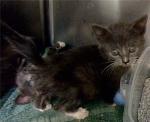
Cats do not require too many baths. But, when you find a kitten on the street and take the little tyke home, you need to bath away the fleas and grime, maybe lice and ticks, too.
- Be sure the kitten looks alive and strong enough for a bath. Some kittens are so anemic from fleas sucking their blood they will become too cold, and die from a bath. If you are worried, and can’t get right to the vet, use a fine-toothed flea comb to pick the fleas off of the kitten. Don’t be surprised if there are several hundred fleas!
- Gather your supplies ahead of time. Towels, blow dryer, brush, spray nozzle or pitchers for warm water.
- If you have sterile eye lubricant, lubricate the kitten’s eyes to prevent soap from blinding the tyke.
- Start by holding the kitten with the head away from you. If you allow the kitten to contemplate your shoulders and neck, kitten will climb you with sharp little kitten claws, and you will not have a successful experience!
- Use tearless kitten shampoo. Be certain, absolutely sure, the shampoo you use states in writing that it is safe for cats and kittens. Do not use dog products Flea and tick shampoo is unnecessary and may be toxic.
- Wet the kitten, while holding your hand over the face to guide water away from the ears and eyes. Let the water drain out of the sink or tub. Kittens hate immersion into the water.
- Turn running water off whenever possible. Kittens usually are petrified of running water.
- Start the shampooing by putting some shampoo in a small cup with warm water, about 1:4 dilution (if you use cheap shampoo, you may need 75% shampoo to 25% water)
- Apply the lather first to the kitten’s head in a ring around the skull just by the ears and under the chin. The reason for this is: fleas are smart. When they sense you, your hands, the soap, etc, they run to the eyes and the short, dense fur around the eyes and nose to escape your bath.
- Create a “ring of death” of soap around the face, so the fleas die from the lather as they try to reach the “promised land” of the face.
- Lather the body and scrub the kitten from head to tail and back to toes, especially under the tail and between the toes.
- Rinse by using a spray nozzle or pitchers of warm water. Rinse until you’re bored. Until you are looking at the water on the kitten and you aren’t sure if there are a few soap bubbles, or just the pattern of the water glinting on wet fur. Rinse one more time to be sure
- “The secret to a good bath is a good rinse,” a wise show groomer once told Doc Truli. (She also said, “and the secret to a good groom, is a good bath.”
- Towel dry the kitten by rubbing the body gently, you may need several towels. You may try a blow dryer if the kitten is not unduly frightened, but test the heat with your hand constantly.
- Be sure kitten is warm and dry after the bath.
- You may flea-comb renegade fleas from around the eyes and nose after the bath.
Isolate the kitten from your cats for 30 days. See the vet right away, and retest for feline leukemia after thirty days to be sure your first test was not a false negative.
2 Responses
leave one →

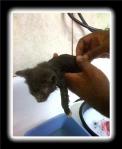
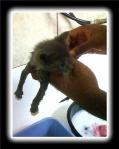
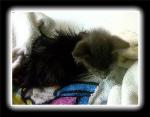
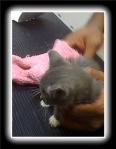


Love reading your blog, I usually learn something interesting stuff.
Emily Randall from Husky Training.net
If you see blood in the water when you bathe a kitten or cat, puppy or dog, most likely, this is red blood from flea poop. The fleas suck blood, they digest the blood. Then, their flea poop is actually little black pellets that look like specks of dirt. This digested blood turns red in water.
I hope this helps the person who searched for “blood in water when i bathe kittens” and other people with the same concern.
–Doc Truli